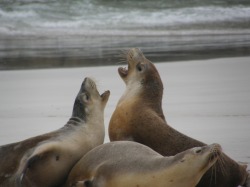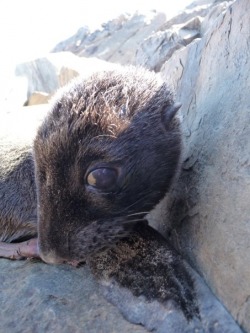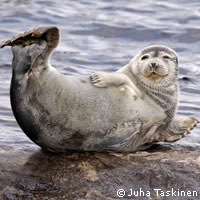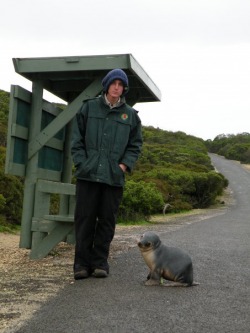A Year In Europe
Australian Sea-Lions

In 2007 I gained work with National Park's and Wildlife at Seal Bay conservation park. I was employed as an Interpretive Officer which is really just a fancy word for a tour guide. My primary job was to take tourists into the colony with the animals. The colony is wild so supervision is required to make sure the animals are not being disturbed by large amounts of people during the day. During my 2 and a half years I was also involved in some of the research projects happening at Seal Bay. Being an endangered species and endemic to Australia efforts are now being pointed in the seals direction and with Seal Bay being the most accessible colony a lot of the research efforts are being focused on the site. National Parks runs a micro-chipping program during breeding seasons which allows workers to recognise and follow the progress of an individual throughout it's life by scanning the chip and recording the number. Weekly colony counts are also done to give an idea of how many individuals are on land and out at sea at any given time. As well as this a lot of privately funded research takes place too. Mainly university funded, I was lucky to meet an array of highly experienced scientists and biologists who would frequent the site to carry on with different projects. The largest threat the species faces are marine pollution including nets, ropes, bags and all sorts of plastics. The second largest threat to the species is recreational and commercial fishing. Bi-catch is a big problem where commercial fishing is concerned and un-sustainable recreational practices as well as fishing line and hooks being thrown into the ocean plays it's part too.
New-Zealand Fur Seals

Kangaroo Island is also home to two large colonies of New-Zealand fur seals. This species breed annually and each season a mark and re-capture program is run. Although the numbers of these two colonies are both increasing roughly 1000 individuals each season the program is still run and looks as though it will continue to run. The mark and re-capture program takes about a week. The program is started by catching a large amount of pups within the colony and marking them. In this case we shave the head. For the rest of the week we will walk through the colony counting marked pups and recording the number we re-sight each day. This gives an idea of mortality rate and whether or not the animals prefer particular areas of the colony. At the end of the week we spend one day catching pups at random (marked or un-marked) and weighing and measuring. I was honored to work on this project 3 years running. These colonies are located in some of the most spectacular and isolated areas I have ever seen, anywhere. If I had the opportunity to go again I would not hesitate. This species lives relatively close to the Australian Sea-Lions. It is interesting to watch the NZFS gain numbers at such a dramatic rate yet see the ASL's decline so rapidly. New-Zealand fur seals are a locally endangered species in other areas such as Tasmania and different programs are being run in these areas to try and preserve the species. The biggest threat to this species is commercial fishing.
Saimaannorppa

The seal I would love to see in the wild and of course work with. With a population of roughly 250 animals it is a case of get in and see them while you can. This species varies from the other seals I have worked with in a few ways. All Sea-Lions and Fur Seals around the world fall into the category of and 'eared seal'. Simply put, they have external ears where as 'true seals' (IE. Saimaannorppa) do not have external ear flaps. Eared seals are capable of walking on all four flippers. They are quite capable of out running people because they have hip bones which allow them to maneuver well over soft sand and rocks. True seals do not have hip bones. They also have much shorter flippers than eared seals and as a result are not very agile on land but more aquadynamic which increases speed in the water. Saimaannorppa also live in fresh water which is quite a rare trait for a seal. They breed in February which is a very cold time in Finland. They give birth to there young in snow dens which help shelter the pups from predators while mum is hunting. Annual surveys are done during the breeding season to try and determine how many breeding females remain and what percentage of young survive during the season. The biggest problem this animal faces is bi-catch in fishing nets although, just like every other example of this around the world a large group of people choose to believe otherwise.

